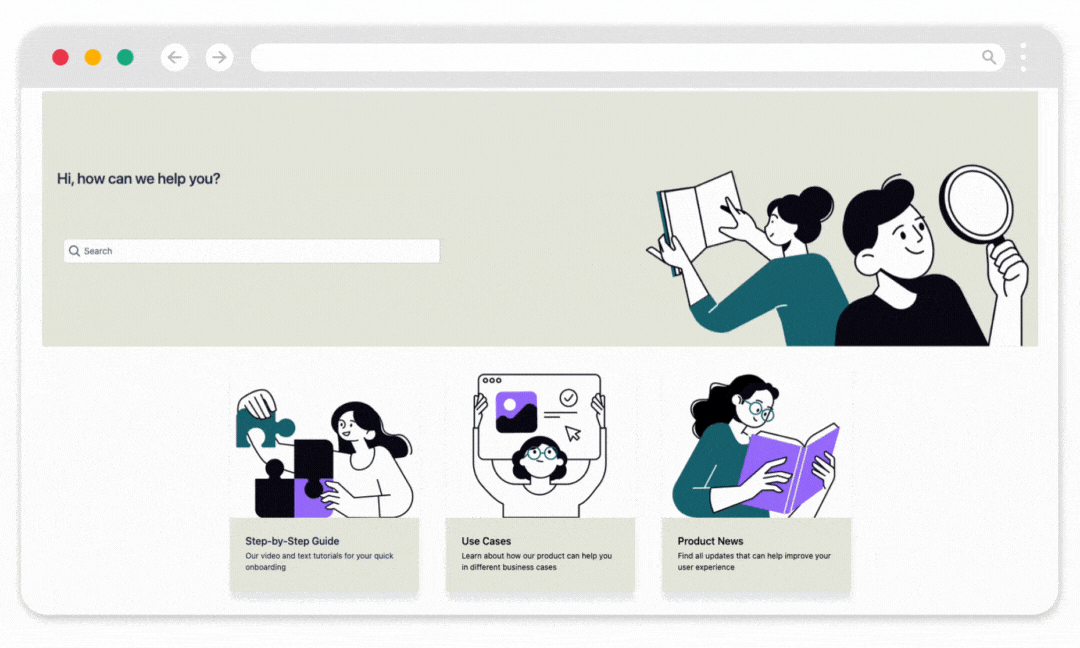How to create a knowledge base in seven simple steps
Share on socials
How to create a knowledge base in seven simple steps

Jump to Section
Jump to section
What is a knowledge base?
The benefits of a knowledge base
How to create a knowledge base
Best knowledge base software
What is a knowledge base, and how do you make one? Get to grips with building a knowledge base in our easy seven-step guide.
If you’re looking for an effective way to share information with your knowledge workers and collaborate across teams, you need a knowledge base. But what is a knowledge base, and how do you create one? Read on to learn more.
This is a general guide. If you have Confluence and want to learn specific setup steps, check out how to create a Confluence knowledge base.
What is a knowledge base?
A knowledge base is a self-serve database containing a collection of information that everyone can access easily. Knowledge bases can be internal (for employees) or external (for customers), but both types help people search for and access the information they need at that moment.
What are the benefits of a knowledge base?
Being able to access information and documents freely, without having to ask for help, makes doing our jobs a lot easier. A knowledge base saves time and improves productivity - with a quick search, up pops the information you’re looking for.
A knowledge base can reduce training time, guide new employees through onboarding effortlessly, and ensure you preserve company knowledge (also known as institutional memory). This keeps documentation consistent, accessible, and updated.

A knowledge base created by Kolekti in Confluence
How to create a knowledge base
We've condensed knowledge base creation into seven simple steps:
1. Determine the purpose of your knowledge base
Why are you creating your knowledge base? Is it because your team lacks cohesion? Or perhaps you don't currently have a space to share knowledge and collaborate. Whatever your reason for creating a knowledge base, figure it out so you can build something that delivers value.
2. Research your knowledge base platform options
There are tons of knowledge base software available on the market, but which one suits your business needs the most is for you to decide. Our advice? Take advantage of product demos to see the tools in action, share your specific business goals and challenges, and ask plenty of questions.
For more information, look at our guide to the best work collaboration tools.
3. Spend time structuring your content
Without structure, no one can find anything! Separate content into sections to help users find their way around. For example, you could create team sections such as ‘Marketing’ and ‘Sales’.
User experience is key to successful knowledge base creation. Let's say you're onboarding new employees: create a section dedicated to common questions and challenges new starters may have. You need each section to provide value, so take time to figure out your audience, what they need to know, and how to present that in an easily digestible way.
4. Create new content and repurpose existing content
Creating content is the most time-consuming part of building a knowledge base. You can generate content ideas in seconds, but writing it all? Days, weeks or months could lie ahead of you. That's why repurposing content is a great way to get ahead quickly.
You might have access to old video guides or documentation you can re-shape and edit, helping you build your knowledge base much faster and easier.
5. Make your content easy to find
By tagging your content with obvious (and not so obvious) page labels, you improve your readers’ experience and journey through your knowledge base. It takes 57% of workers more than 30 minutes daily to search for the information they need. By labelling your knowledge base content coherently, you can eliminate any frustration users might have when searching for relevant content.
6. Increase user adoption
Research shows that 49.96% of installed software is unused by employees. You don't want to spend time creating a knowledge base for teams to just ignore it - that's why you need to boost user adoption. Announce your new platform, share its benefits, create demo videos to show how to use it, and ask users for feedback (and then implement all useful feedback).
7. Get into a routine of maintaining your knowledge base
You should commit to regularly updating your content. Outdated content doesn’t serve its purpose. Consider conducting a content audit quarterly, twice or once a year - the frequency is up to you. Just make sure it's a priority and that it remains consistent.
If your knowledge base is big or you struggle to maintain it alone, we recommend nominating admins for different areas of your knowledge base to keep an eye on content. However you do it, just remember: relevant content only!
What's the best knowledge base software?
Ultimately, there's no 'one best' knowledge base software. The best fit for you depends on your business goals and needs. Find one that aligns with both, and you're onto a winner.
BUT, if you're unsure where to start your research, here are three of the biggest players out there: Confluence, Tettra and Guru. All three have their pros and cons, but in a nutshell:
- Confluence is perfect for teams looking to make collaboration effortless. Confluence knowledge base features include real-time editing, a single source of truth of organisational information, and its advanced search engine makes it easy for users to find what they're looking for. It even has its own AI assistant, Atlassian Intelligence, to help you get your knowledge base off the ground quicker.
- Tettra has a great feature that helps nudge internal experts to verify page content. This means it's never been easier to ensure content is updated regularly. Another helpful feature of Tettra is its page metrics — users can measure the impact of their knowledge base by analysing page views, ratings and feedback.
- Guru’s search engine is powered by AI, showing only useful information to users. If you use Slack, Guru can transform popular Slack topics into content, helping employees find only relevant and useful content.
Want to boost your company’s knowledge management?
Get tips and insights for knowledge workers straight from the Kolekti blog.
Written by

Content Writer
Helen is a freelance content writer specialising in Software as a Service (SaaS). She has a BA Hons degree in English, a Chartered Institute of Marketing qualification, and over ten years of experience in content marketing.



